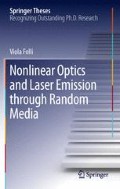Abstract
In the last chapter, we have seen how to analytically treat the interplay between nonlinearity and disorder in the framework of the spin glass theory. The emerging results show how the increasing degree of disorder can drastically change the underlying thermodynamics by switching the optical device from a standard laser to a random one while controlling the furnished energy permits to observe the nonlinear emerging phenomena, like the mode-locked transition. By an experimental point of view, the latter mechanism is much simpler to control and hence the related literature is much wider than the former one. Here, we want to visually demonstrate through a set of experiments that the random laser emission depends not only on the furnished energy, the nonlinear processes, but primarily on the structural informations, that is the degree of disorder inside. In order to study how random laser features are affected and controlled by the state of the motion of the sample, and then on the disordered considered configuration, we have to choose the more appropriate physical system. Here, we use shaken granular materials.
Access this chapter
Tax calculation will be finalised at checkout
Purchases are for personal use only
Notes
- 1.
We use “first order” to denote the fact that scattering is neglected, indeed scattering events in the light-matter interaction Hamiltonian appears at second-order.
- 2.
The laser spot is measured by a scanning blade technique
- 3.
Without scatterers inside.
- 4.
i.e. the transmission.
References
Cao H (2003) Waves Random Media Complex Media 13:R1
Jaeger H, Nagel S (1992) Science 255:1523
Jaeger H, Nagel S, Behringer R (1996) Rev Mod Phys 68:1259
Poeschel T, Brilliantov N (2003) Granular gas dynamics, vol 624. Springer, Berlin
Poeschel T, Luding S (2001) Granular gases, vol 564. Springer, Berlin
McLennan J (1989) Introduction to nonequilibrium statistical mechanics. Prentice Hall, Englewood Cliffs
Puglisi A, Visco P, Barrat A, Trizac E, van Wijland F (2005) Phys Rev Lett 95:110202
Lawandy NM, Balachandran RM, Gomes ASL, Sauvain E (1994) Nature 368:436
Goeuedard C, Husson D, Sauteret C, Auzel F, Migus A (1993) J Opt Soc B 10:2358
Briskina C, Markushev V, Ter-Gabrielyan NE (1996) Quantum Electron 26:923
Cao H et al (1999) Phys Rev Lett 82:2278
Ryzhkov M, Markushev V, Briskina C, Cao H, (2005) Lasing in powdered ZnO: current state of affairs. In: Proceedings of CAOL 2005. 2nd international conference on advanced optoelectronics and lasers, vol 1, pp 72–75
Dice G, Mujumdar S, Elezzabi A (2005) Appl Phys Lett 86:131105
Popov O, Zilbershtein A, Davidov D (2006) Appl Phys Lett 89:191116
Meng X, Fujita K, Zong Y, Murai S, Tanaka K (2008) Appl Phys Lett 92:201112
Meng X, Fujita K, Murai S, Tanaka K (2009) Phys Rev A 79:053817
Wiersma DS, Vanalbada MP, Lagendijk A (1995) Nature 373:203
Wiersma DS (2008) Nature Phys 4:359
Letokhov VS (1968) Sov Phys JETP 26:835
Wiersma DS, Lagendijk A (1996) Phys Rev E 54:4256
Balachandran RM, Lawandy NM, Moon JA (1997) Opt Lett 22:319
Guerin W, Michaud F, Kaiser R (2008) Phys Rev Lett 101:093002
Cao H, Ling Y, Xu J, Cao C, Kumar P (2001) Phys Rev Lett 86:4524
Anderson PW (1958) Phys Rev 109:1492
Conti C, Leonetti M, Fratalocchi A, Angelani L, Ruocco G (2008) Phys Rev Lett 101:143901
Author information
Authors and Affiliations
Corresponding author
Rights and permissions
Copyright information
© 2012 Springer Science+Business Media Dordrecht
About this chapter
Cite this chapter
Folli, V. (2012). The Granular Laser. In: Nonlinear Optics and Laser Emission through Random Media. Springer Theses. Springer, Dordrecht. https://doi.org/10.1007/978-94-007-4513-1_9
Download citation
DOI: https://doi.org/10.1007/978-94-007-4513-1_9
Published:
Publisher Name: Springer, Dordrecht
Print ISBN: 978-94-007-4512-4
Online ISBN: 978-94-007-4513-1
eBook Packages: Physics and AstronomyPhysics and Astronomy (R0)

